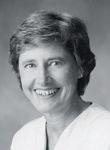Article
View from 'shoulders of giants' offers new vision
The president, president-elect, and executive vice president of the American Academy of Ophthalmology (AAO) recently offered a "state-of-the-profession" message during the opening session of the AAO annual meeting in Chicago. All three executives shared in a celebration of past achievements, current conditions, and future opportunities in ophthalmology

Susan H. Day, MD, outgoing AAO president, told colleagues that ophthalmology could continue to grow only if professionals contributed their "time, treasure, and talent."
To help build an understanding of the need for continued professional support, Dr. Day led off the session with a series of object lessons. Dr. Day, first woman to hold the office of AAO president, compared ophthalmology with music and cities. She made her point by using the examples of roots, evolution, and vulnerabilities.
"Within these boundaries, creative opportunity is without limits; beyond them the vulnerability is that noise, rather than music, is the product," Dr. Day added.
Also, Dr. Day focused on cities, explaining how each city represents great diversity of character. For example, Paris, Sydney, and Istanbul are all vital cities, but each is very distinctive in what makes it notable. The distinctive qualities emerge in large part due to individuals with diverse exper-tise working together. But cities have vulnerabilities, too. New Orleans, for example, located below sea level and surrounded by water, is very vulnerable to hurricanes.
"Urban areas, just as music's essence, depend on laws of nature as well as our ability to address these vulnerabilities societally," Dr. Day said.

"We stand on the 'shoulders of giants' who applied the scientific principles of optics and medicine to this goal," Dr. Day said. "We benefit from the technological advances and from the genius that apply them to our field. We've evolved to encompass solo and group practitioners, refractive surgeons, ocular pathologists, and visionaries. We have diverse expertise in education, practice management, ethics, coding, and advocacy."
Despite the heritage and depth of capabilities that ophthalmology boasts, the profession still faces vulnerabilities. Those liabilities include scope of practice and reimbursement.
"Each of you must play a role in these vital issues whether it be through the contribution of time, treasure, or talent," Dr. Day said. However, the specific vulnerability that she wanted to address related to other consequences of the increasing complexities of practicing ophthalmology.
"Of all principles that underpin our existence, there is none more important than trust-trust by our patients and by society that we serve their needs," Dr. Day continued. "In this time of evidence-based medicine, nothing could be less quantifiable than trust. Yet, there is no natural law that is more fundamental to professionalism than the phenomenon of one human caring for another. The essential core in this relationship is trust. For medicine, society's initial scope of trust was simple: it was one-on-one doctor-patient relationship. This model has vastly expanded as medicine has increasingly corporatized."
Age of accountability
Dr. Day compared the situation with comparable business arenas, citing the Enron/ Andersen debacle. The right to know supersedes trust, resulting in new rules for governance and financial accountability.
Newsletter
Don’t miss out—get Ophthalmology Times updates on the latest clinical advancements and expert interviews, straight to your inbox.





